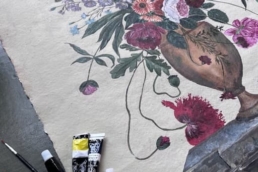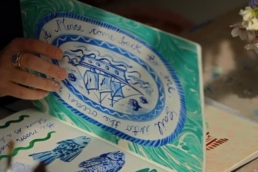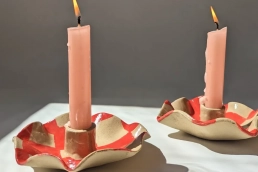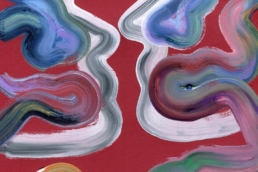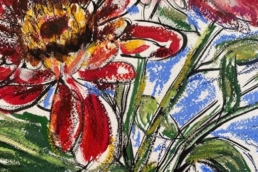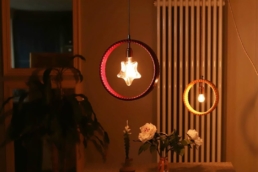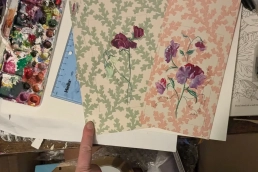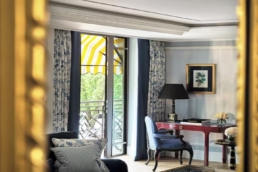We catch up with Jessie de Salis in her Somerset barn studio to talk about the beauty of hand-printed textiles, the emotional depth to her bold designs, and how she captures the shifting moods of the natural world.
Jessie shares how folklore, memory, and landscape inform her process; and the quiet magic of printing by hand, embracing imperfection and individuality in every piece. We also discuss the joys and challenges of rural studio life, building a slow, intentional practice, and the stories woven into each batch of fabric Jessie creates.

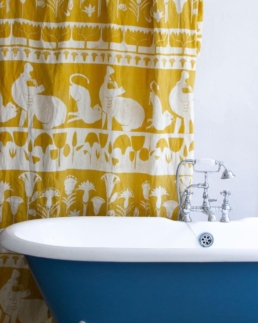
1. Can you tell us a bit about yourself and your artistic journey?
My name is Jessie de Salis, I am a textile designer and screenprinter. I have always been into textiles. At school I drew patterns over every piece of paper in my grasp. At uni, while studying textiles, I covered every scrap of the wall space with fabrics (at the time I thought this looked like a very sophisticated tent).
2. What inspired you to pursue your craft? Was there a defining moment or influence that sparked your passion?
During lockdown I began my screen printing journey and developed my textile craft. I started screen printing on the kitchen table and realised “this is me now. I am a screen printer”. I fell in love with the look of hand printed fabrics: the way the inks sit on the cloth, the freshness of the colours and the crispness of the print. It’s the most exciting and satisfying moment when you print a design, lift up the screen and see your image come to life.
I work with my cousin Alice. We now hand print all our products in a Somerset barn, surrounded by the flowers and the bees. Treading lightly on the earth is a guiding principle. We aspire to make natural handcrafted pieces that will carry on telling stories for years to come.
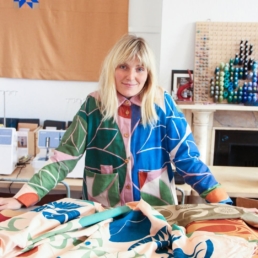
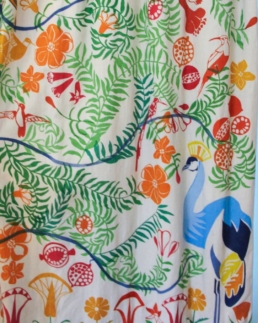
Your craft
3. How would you describe your work in three words?
Hand-printed, Joyful, Colourful
4. What materials or techniques do you use, and why are they important to your process?
Treading lightly on the earth is at the heart of my process. Our fabrics are sourced from a European mill powered by green energy. Our dyes are hand mixed and water based. Screen printing allows me to oversee the whole print process.
I love printing my fabrics by hand because I can make beautiful things locally. Screen printed fabrics are imperfect, unique and each separate piece tells its own story
5. Can you tell us about a favourite piece you’ve created and the story behind it?
A lovely project we recently worked on was decorating a Somerset yurt. Alice and I had a simple mission, not to buy anything new. We screen printed on old table cloths and covered the yurt walls with patterns. It was such a joy to create something from reclaimed materials and transform old fabrics with print.

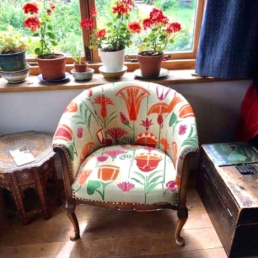
Creative process
6. What does a typical day in your studio or workshop look like?
Every day is quite different. My studio is great, I’m super lucky to have the space and totally wouldn’t be able to print big runs of fabric without it. Alice and work with the seasons which means long print days in summer when the light is good. Print days are a joy. It’s amazing to see a 10m fabric print coming alive in front of your eyes.
7. Do you have any unique rituals or habits that help you stay creative?
I am currently journaling and drawing every day. Even if it’s just a few words and a sketch on my bed it keeps the ideas going.
8. How do you handle creative blocks? Do you have any strategies or tips for overcoming them?
Being a designer is about collecting visual research wherever you go. This can be through places I visit, people I meet and stories of the past. If I’m feeling stuck I’ll try to go to galleries, buildings or botanical gardens and draw. Sometimes I’ll get a bunch of art books out and look at designs I find inspiring.
Challenges and successes
9. What’s the biggest challenge you’ve faced as a maker, and how did you overcome it?
Learning how to screen print perfect prints has been so hard, there is so much that can go wrong. I think the biggest challenge has been keeping motivated and starting again when something doesn’t go to plan, which happens from time to time when you’re doing everything by hand.
10. What’s been your proudest moment or achievement so far?
Setting up a print studio has been my proudest achievement I think. There has been so much research, building and planning involved and it’s taken years. I know it’s a small thing but it’s so nice getting photos from customers to see how they have used my fabrics.
11. What’s your favourite quote you’ve ever heard about your work? Who said it, or what was the name of the publication?
"Soft green pea plant tendrils curling around bed heads, Bauhaus inspired napkins adorned with vivid blue and soft green circles and gloriously sunny yellow petals spread gracefully across a table."
- Rosanna Spence, Bristol Life, March 2025
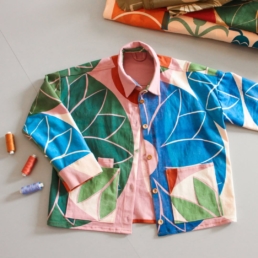
Inspiration
12. Where do you draw inspiration from for your work? What sparks your imagination and creativity?
I love bright and bold designs . Also, flowers, grasses, animals and trees. Nature is a constant source of inspiration, just look out your window and you have a pattern.
13. Do you have a favourite artist, maker, movement, or tradition that has influenced your craft?
I always find myself returning to the Bauhaus School of Art. I love Josef and Anni Albers. The clean crisp shapes from their work look so contemporary to me: beautiful satisfying circles and simple squares. The Bauhaus had such an inspirational attitude to design. For the Bauhaus, design is a considered and spiritual process.
Another huge inspiration is the amazing Hilna Af Klint. Her paintings are free, bright, expressive and on such a scale. I remember when I first saw her work I bought the book straight away, and became so obsessed with her paintings and her story. When I discover a designer I love to buy the book, listen to interviews and become immersed in their work.
A friend recently gifted me a beautiful hardback book of the work of Marimekko – the dream company in design and ethos! It was started by visionary Armi Ratia who converted an old oil cloth factory into an incredible textile printing studio where they printed huge scale fabulous designs. It’s a dream of mine one day to establish a textile collective in a disused building, creating sustainable and local textiles and building a local community of designers.
14. How does colour influence your practice; is it an important part of your process? Do you have a particular palette or favourites? Any go-to sources for colour inspiration?
I see the world through colour and remember it through colour. It really affects my mood. Even when I start a design using soft greys and a muted pallet, a bright colour will sneak its way in!
Colour leads my designs. It’s the first thing I work out. I like working with contrasting colours and seeing how colours relate to each other. A very pale pink next to a white looks muted, but next to a navy it pops. Screen printing limits my designs to 6 colours so the colours that are chosen need to be carefully considered. I create colour palettes through emulsion paint charts – a great way to quickly see what works together.
Perspectives and goals
15. What role does your environment play in shaping your creativity?
As I am writing this we are entering spring, which is my favourite season and brings me so much inspiration. The weather and the environment really affect how I create, when the world is warm and alive there’s nothing nicer to do than sit outside and paint designs.
16. What do you want people to feel when they experience your work?
I want my work to lift a space and brighten a room. My designs are quite bright and look best when picking up other colours.
17. What are you currently working on, and what excites you most about it?
I am currently figuring out how to hand print wallpaper. Paper works so differently to fabric and is used in a very different way. I love to think about how materials will be used and seen in a place and how this affects the design.
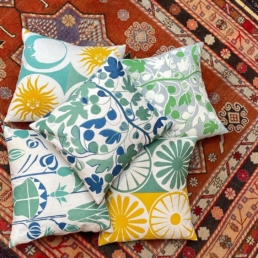
Advice and reflection
18. What advice would you give to someone starting out as a maker?
Being a maker can be tough, but it’s incredible to do what you love. Be slow, be perfect, be super proud of who you are and what you put out into the world. Also, something that many people have told me over the years, things always work in three.
19. If you could go back to the start of your career, what advice would you give your younger self?
Don’t take everything so seriously. You’re living your dream, have fun and enjoy the journey.
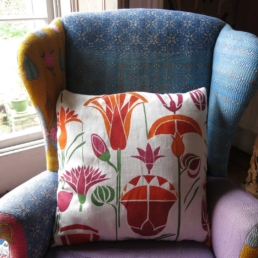
Closing thoughts
20. If you could collaborate with any artist, past or present, who would it be and why?
This is a fun question. Either William Morris or Mattissee
21. Where can people find your work, and how can they support you?
Mainly through our website: www.jessiedesalis.com. We have recently started selling through a company called Haines as one of their eco designers. We sell through interior designers, on some independent homeware online stores, some shops and hotels.
Jessie de Salis’ hand-printed fabrics blend bold storytelling, pastoral charm, and an appreciation for the handmade. Rooted in nature, her work honours the rhythm of the seasons and the beauty of variation, where every print holds its own quiet narrative.
Explore Jessie’s latest collections and follow her creative journey:
Support Jessie by browsing her website, discovering her joyful handmade pieces, and joining her colourful, creative world on Instagram.


